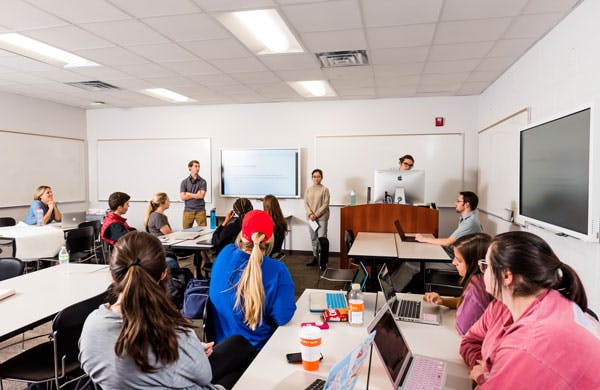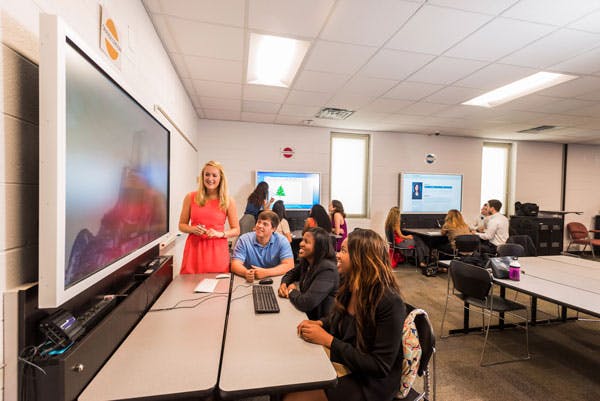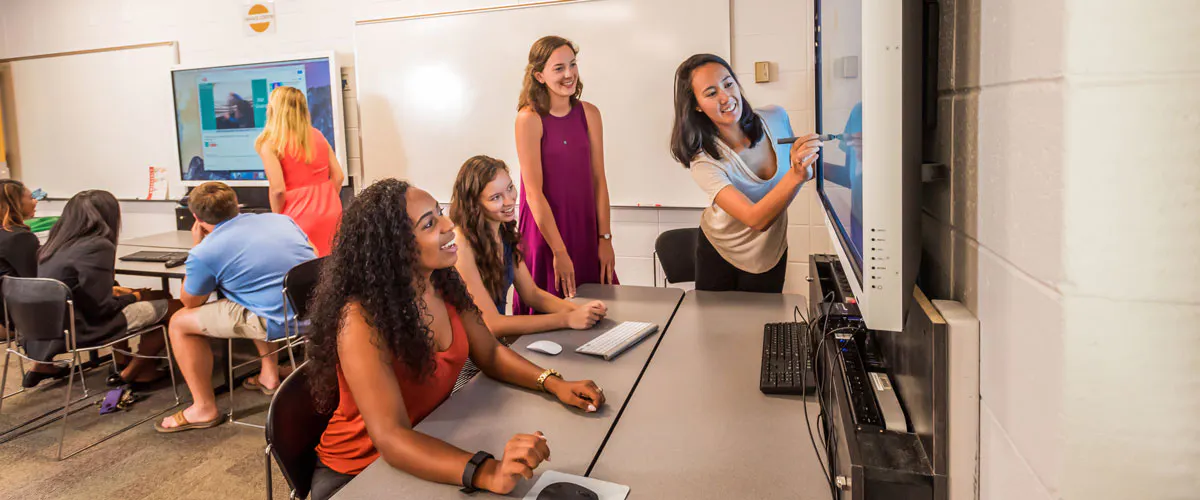Active classrooms, active learning
With various ongoing projects and 17 state-of-the-art, multiscreen classrooms—including the construction of a new research space in River's Crossing—the College of Education is home to the most active learning classrooms on campus at the University of Georgia.
Over the past four years, the College of Education has redesigned and incorporated various classroom technologies in both Aderhold Hall and River's Crossing to enhance student engagement and provide faculty the flexibility to focus on applying innovative and effective teaching methods.
"Virtually every one of our classrooms is active in the sense that a professor can lecture, but students may also break out into groups to work on a project or look at a question more closely," said Ralph Knapp, director of the Office of Information Technology in the College of Education. "As a recruiting tool, we have more opportunities for undergraduate students, graduate students and faculty to implement high-tech, active-learning pedagogies than anywhere else in the country."

Making connections with technology
By using active learning in the classroom, students shift from passively receiving information from their instructors to participating in more collaborative, hands-on activities.
Devices, such as Solstice pods, allow for wireless content sharing from any laptop, tablet or phone, so students and faculty can cast their content onto multiple screens during class to encourage collaboration and interactivity.
"I only see my students twice a week, so every minute in the classroom counts," said Gretchen Thomas, a lecturer in the department of career and information studies. "I want them to walk out the door and always be able to say they've learned something, and that takes a lot of effort and multiple active learning strategies."
Other classroom technologies, like laptops on movable carts, projectors and screens, document cameras and whiteboards, give faculty like Thomas the opportunity to share content in a variety of different ways, while simultaneously allowing students to build a bridge between their existing knowledge and any new information shared during lectures.
"It's easy to just talk about technology, but it's about the human connection with the technology where meaning is made," said Nicholas Holt, director of innovation in teaching and technology in the College of Education. "The element that we've echoed through a number of rooms has to do with some thoughtful or purposeful flexibility, so we're not just building a room for a single purpose."

Developing new ways to engage
Up-to-date hardware systems provide faculty in a range of subject areas, such as mathematics education and instructional design and technology, the opportunity to test different types of software; create stop-motion and green screen instructional videos; and experiment with web-based, educational resources designed to support representation, engagement and expression.
"Students learn by doing and while lecture is appropriate in some areas, I can use technology to deliver lectures, so students are able to view content on their own time and at their own pace," said Rob Branch, a professor and department head in the College of Education. "Such a pedagogical approach gives students an immediate feeling of being part of the process; and further, the results have direct meaning for students."
Each semester, faculty in the College can enhance their teaching skills and learn how to use the latest technologies by attending the Innovation in Teaching Technology Faculty Academy led by Holt, which provides professional development for instructors interested in implementing new, active learning strategies into the classroom.
With a general understanding of instructional technologies, faculty can start redesigning their courses to incorporate engaging activities for their students. Other technologies, like microphone and camera connections in the floors, ceilings and walls, allow faculty and graduate students to capture audio and video footage of lectures, activities and conversations for research purposes.
"What we really see in these rooms is whoever teaches configures them to the way they teach, and then the next person comes in and they configure it again, and there's a real beauty in seeing that," said Holt. "Everybody has a different way of approaching instructional technology. We've stepped out of the cookie-cutter model and recognize that some rooms can be more dedicated or more useful in certain kinds of pedagogical approaches."
